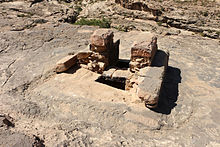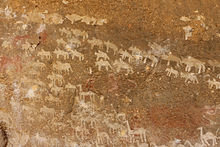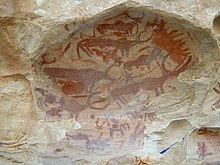Qohaito
Appearance
You can help expand this article with text translated from the corresponding article in Italian. Click [show] for important translation instructions.
|
Qohaito (
Debub region of Eritrea. It was a pre-Aksumite settlement that thrived during the Aksumite period. The city was located over 2,500 meters above sea level, on a high plateau at the edge of the Great Rift Valley. As of 2011[update], Qohaito's stone ruins have yet to be excavated. The ancient port city of Adulis is directly to the east, while Matara lies to the south.[1][2]
History

fifth millennium BC, while the town is known to have survived to the sixth century AD. Mount Emba Soira
, Eritrea's highest mountain, lies near the site, as does a small successor village.
Qohaito is often identified as the town Koloe described in the
The ruins at Qohaito were first located in 1868. However, they were at the time erroneously identified as a "Greek depot".[5] A related site outside of Senafe, Matara, lies about 15 kilometers to the south, and was excavated in the 1960s.


See also
Wikimedia Commons has media related to Qohaito.
References
- ^ "Qohaito | Adi Keih, Eritrea Attractions".
- ^ "Qohaito | Archiqoo".
- ^ G.W.B. Huntingford, Historical Geography of Ethiopia from the first century AD to 1704 (London: British Academy, 1989), pp. 38f
- ISBN 978-1847010414.
- ^ C. R. Markham, "Geographical Results of the Abyssinian Expedition", Journal of the Royal Geographical Society, 38 (1868), p. 23
